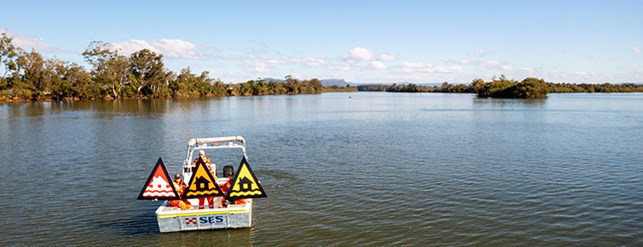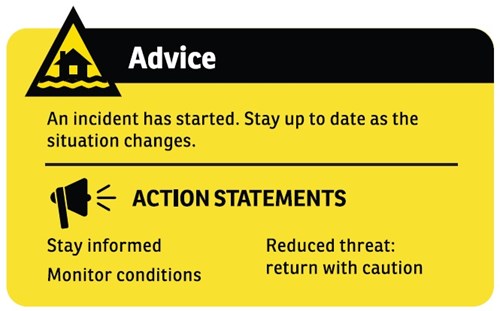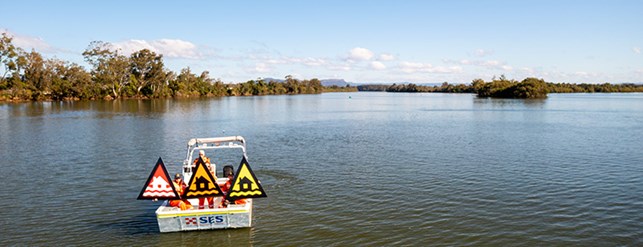New flood warning system as SES braces for even more wet weather
What we should do as floodwaters rise will become clearer from Friday (30 September) as the NSW State Emergency Service (SES) adopts a new warning system.
In one of the organisation’s largest changes to its public messaging in its history, the NSW SES will switch to the Australian Warning System (AWS) at the end of the week.
SES change manager Andrew McCullough said the public had let them know they wanted clearer information and action statements when disaster struck.
“What this new system does is when a warning is issued, it makes clear the level of severity and what the community needs to do if they’re in the area,” he said.
The system was run past 20,000 Australians as part of the third largest social research project in the country.
Mr McCullough said it proved the warnings and colours used spurred people into action, which could potentially save lives.
“Ideally if people leave earlier, it minimises the need for our volunteers to do life-threatening rescues,” he said.
There are three levels of warning in the AWS:
- Advice – an incident has started, stay up to date and monitor conditions in case the situation changes
- Watch and Act – conditions are changing and you need to take action now to protect your family, such as preparing to evacuate and avoiding certain areas
- Emergency Warning – you may be in danger and need to take action immediately, be that evacuation, sheltering in place or moving to higher ground
Each warning will include the location and type of hazard impacting the community, the warning level and an action statement to guide the community’s reaction.
A new interactive online map – similar to what the Rural Fire Service uses to communicate the location of bushfires – will also go live on Friday.
It will allow people to navigate the state, see current warnings and see if they apply to them.
Mr McCullough said while all emergency services would switch to the new system over the coming years, NSW wanted to get in earlier.
“We want to be prepared for the upcoming weather this season, we know floods are going to impact us again,” he said.
“Victoria made the switch earlier this year, and we know floods cross our state borders, just as people do. This way the messaging will be more consistent for our border communities.”
Those who have been impacted by floods in the past have been urged to learn the new system in case of future disasters.
From the SES-Our Warnings
The NSW SES is moving to the Australian Warning System for flood and tsunami warnings on 30 September 2022.
The Australian Warning System (AWS) is a nationally consistent, three-tiered approach designed to make warnings clearer and lead people to take action ahead of severe weather events. The warning system comprises warning levels, action statements, hazard icons, colours and shapes.
Warning levels and action statements
There are three levels within the AWS – Advice, Watch & Act and Emergency Warning. For each level, there are a series of clear action statements to guide positive action by the community. These include ‘stay informed’, ‘prepare to evacuate’ and ‘move to higher ground’ as shown below:
- Advice – an incident has started. Stay up to date in case the situation changes.
- Stay informed
- Monitor conditions
- Reduced threat: return with caution
- Watch and Act – conditions are changing and you need to start taking action now to protect you and your family.
- Do not enter floodwater
- Prepare to evacuate
- Prepare to isolate
- Avoid the area
- Emergency Warning – the highest level of warning. You may be in danger and need to take action immediately.
- Evacuate now / Evacuate before [time]
- Shelter now
- Move to higher ground

Each warning has three components:
- Location + Hazard: The location and the type of hazard impacting the community (e.g. Lismore flooding).
- Action statement: For each warning level there are a range of action statements to guide protective action by the community. These statements evolve as the warning levels increase in severity. Statements range from ‘stay informed’ at the Advice level, to ‘prepare to evacuate’ at the Watch and Act level, to ‘evacuate now’ in the Emergency Warning level. As the situation changes and the threat is reduced, the level of warning will decrease accordingly.
- The warning level: The severity of the natural hazard event based on the consequence to the community.

Local warnings for your community
The NSW SES utilises a range of sources to build detailed flood intelligence within local communities – including information from flood studies and historical flood data. As part of the transition to the Australian Warning System, the NSW SES has increased flexibility to tailor warnings at the community level, based on the expected consequences of severe weather events.
Accessing NSW SES warnings
Impacted communities will continue to receive flood warnings through the NSW SES website, NSW SES social media channels and by listening to local ABC radio stations.
The NSW SES is also developing an all-hazards warning platform to provide an additional channel for communities to access important warning information.

Frequently asked questions
Will minor / moderate / major terminology still be used?
The Bureau of Meteorology will continue to issue flood warnings with this terminology. The NSW SES will then analyse the expected impact and consequences of these flood warnings to communities in the warning area, and determine the type of warning to issue (Advice, Watch & Act, or Emergency Warning).
Minor, moderate and major terminology will still be used within the flood products from NSW SES, however it will not be part of the headline warning.
For more information, please contact us.
Advice
An incident has started. Stay up to date as the situation changes.
Action Statements Examples
- Stay informed
- Monitor conditions
- Reduce threat: return with caution

Watch and Act
Emergency Warning
There are three levels of warning in the AWS:
- Advice – an incident has started, stay up to date and monitor conditions in case the situation changes
- Watch and Act – conditions are changing and you need to take action now to protect your family, such as preparing to evacuate and avoiding certain areas
- Emergency Warning – you may be in danger and need to take action immediately, be that evacuation, sheltering in place or moving to higher ground
Each warning will include the location and type of hazard impacting the community, the warning level and an action statement to guide the community’s reaction.
A new interactive online map – similar to what the Rural Fire Service uses to communicate the location of bushfires – will also go live on Friday.
It will allow people to navigate the state, see current warnings and see if they apply to them.
Mr McCullough said while all emergency services would switch to the new system over the coming years, NSW wanted to get in earlier.
“We want to be prepared for the upcoming weather this season, we know floods are going to impact us again,” he said.
“Victoria made the switch earlier this year, and we know floods cross our state borders, just as people do. This way the messaging will be more consistent for our border communities.”
Those who have been impacted by floods in the past have been urged to learn the new system in case of future disasters.










